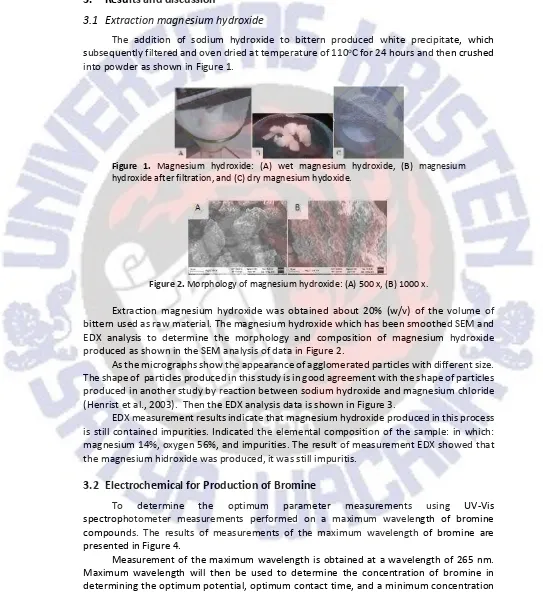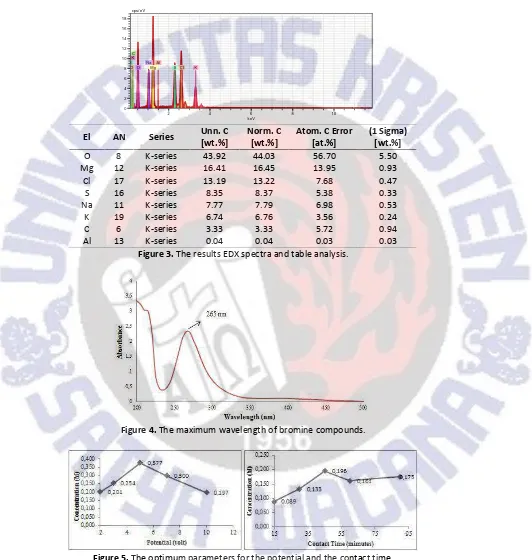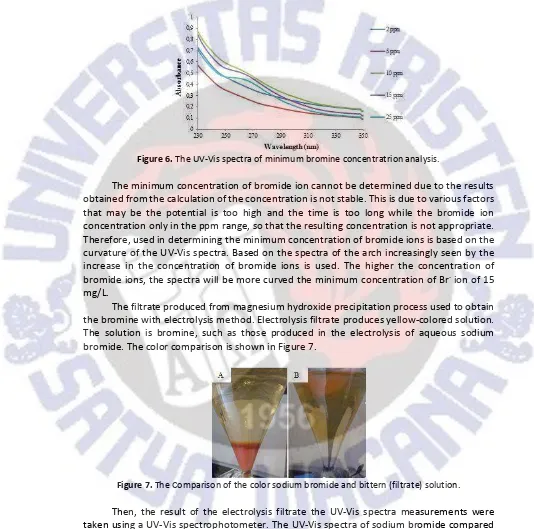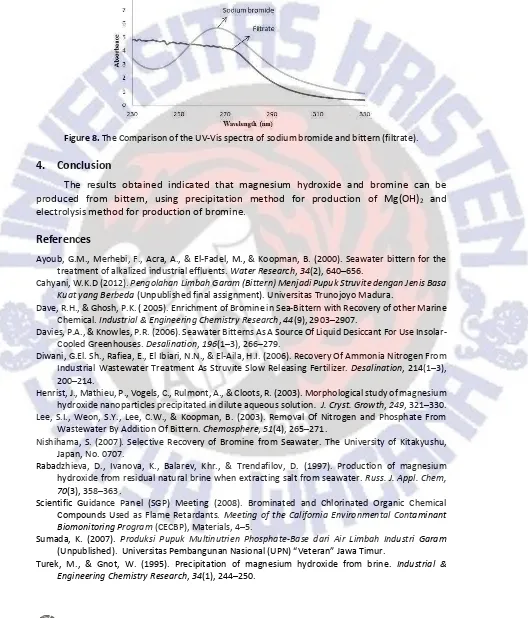Production of magnesium hydroxide and bromine from bittern
Tutika, Wasinton Simanjuntakb, Rudy SitumeangbaGraduate Student, Department of Chemistry, Faculty of Mathematic and Natural Sciences,
University of Lampung, Lampung, Indonesia
bDepartment of Chemistry, Faculty of Mathematic and Natural Sciences,
University of Lampung, Lampung, Indonesia
Abstract
In this research, production of magnesium hydroxide and bromine from bittern has been performed using precipitation method. The Sodium hydroxide solution was added drop-wise from a burette to 50 mL of bittern or Mg2+ solution. Preliminary precipitation experiments were carried out to adjust the super saturation release rate at which the primary nucleation was not dominant. After addition of sodium hydroxide solution, the reaction was stopped, the mixed solution allowed to stand for 5 minutes and the suspension in the crystallizer was filtered. The solid produced was oven dried at 110oC for 24 hours. The magnesium hydroxide morphological was analyzed using Scanning Electron Microscope (SEM) and elemental composition analysis using energy-dispersive spectrometer (EDS). The filtrate was used in electrolysis experiment for production of bromine. The formation of bromine was analyzed using UV-Vis Spectrophotometer. The results were obtained magnesium hydroxide about 20% of the volume of bittern used as raw material. Magnesium hydroxide was analyzed using SEM and EDX, Indicated the elemental composition of the sample: in which: magnesium 14%, oxygen 56%, and impurities. The electrolysis experiments demonstrated that the optimum conditions for production of bromine are potential of 5 volts, the optimum contact time of 45 minutes, and minimum concentration of Br-of 15 mg/L.
1. Introduction
Salt waste (bittern), a byproduct of salt production, is a potential raw material for production of magnesium hydroxide and bromine, since magnesium and bromide ions were
found in high quantity together with several minor components such as Ca2+, Al3+, Fe3+, SO
42-, and I-(Cahyani, 2012). Traditionally bittern has been utilized in limited amount as isotonic
and fertilizer (Sumada, 2007), as a source of liquid desiccant for use insolar-cooled greenhouses (Davies and Knowles, 2006), as a raw material for alkaline industry (Ayoub et al., 1991), additive for the removal of nitrogen and phosphate from waste (Lee et al., 2002), source of magnesium which is used as fertilizer struvite (magnesium ammonium phosphate) (Diwani et al., 2006).
Magnesium hydroxide, the intermediate of magnesium oxide, is used mainly in pharmaceutical industry, refractory, water and wastewater treatment and desulphurization
of fuel gases (Bosster et al., 2003). Seawater is the main source for production of Mg(OH)2
due to the presence of soluble salts of magnesium such as MgCl2 and MgSO4. The
concentration of magnesium ion is about 1272 ppm in seawater and about 30000 ppm in the end bitterns of sodium chloride production units from seawater (Rabadzhieva et al., 1997). Turek and Gnot (1995) investigated the effect of temperature on the precipitation of
Bromine is a chemical with a very wide utilization in the industry for a variety of uses. For example, this element is an important reactant for hydrogenation reactions (addition of hydrogen atoms) to the compound of alkanes to alkenes into compounds, and brominated organic compounds or reactions. This element is also used as flame retardant in the environment (SGP Meeting, 2008). Bromine is found principally in seawater, salt lakes, and underground brines associated with oil. The concentration of bromide ion is about 0, 84 ppm in seawater (Dave & Ghosh, 2005) and about 2, 5 ppm in bittern (Anthony, 2006). Bromide ion is presently recovered from seawater, bittern and industrial waste containing the bromide ion (Nishihama, 2007).
In an attempt to take advantage of its availability and high content of Mg2+and Br-ions,
in this study bittern was used as a source of Mg(OH)2and bromine. Production of Mg(OH)2
was based on the reaction between Mg2+and OH-ions. Therefore, in this study the Mg(OH)2
was produced by addition of sodium hyroxide solution into bittern, and after the solid Mg
(OH)2 was separated, the filtrate contains Br- ion was subjected to electrolysis process in
which the Br-ions were oxidized to Br2at the anode side. For development of the method,
the role of three electrochemical variables, potential, contact time, and the concentration of
Br-ions, was investigated.
2. Materials and methods
2.1
Materials
The chemicals used in this study, sodium bromide, sodium hydroxide, bittern, carbon electrode, and distilled water. And The equipments used in this study, glasware, electrolysis unit, SEM-EDS, and UV-Vis Spectrophotometer.
2.2 Methods
2.2.1 Precipitation of magnesium hydroxide
The sodium hydroxide solution was added drop-wise from a burette to the 50 mL
bittern or Mg2+solution. Preliminary precipitation experiments were carried out to adjust the
super saturation release rate at which the primary nucleation was not dominant. Volume ratio was determined by volume comparisons bittern and sodium hydroxide. After addition of sodium hydroxide solution, the reaction was stopped, the mixed solution allowed to stand for 5 minutes and the suspension in the crystallizer was filtered. The filter cake was oven
dried at 110 oC for 24 hours. The magnesium hydroxide morphological was analyzed using
Scanning Electron Microscope (SEM) and elemental composition analysis using energy-dispersive spectrometer (EDS). The filtrate produced was conducted for obtaining bromine electrolysis. The electrolysis produced was analyzed using UV-Vis Spectrophotometer to identify the bromine content in the filtrate by absorbance at a particular wavelength.
2.2.2 Electrochemical for production of bromine
concentration variation. The electrolysis produced was analyzed using UV-Vis Spectrophotometer to identify the bromine content in the filtrate by absorbance.
3. Results and discussion
3.1 Extraction magnesium hydroxide
The addition of sodium hydroxide to bittern produced white precipitate, which
subsequently filtered and oven dried at temperature of 110oC for 24 hours and then crushed
into powder as shown in Figure 1.
Figure 1. Magnesium hydroxide: (A) wet magnesium hydroxide, (B) magnesium hydroxide after filtration, and (C) dry magnesium hydoxide.
Figure 2.Morphology of magnesium hydroxide: (A) 500 x, (B) 1000 x.
Extraction magnesium hydroxide was obtained about 20% (w/v) of the volume of bittern used as raw material. The magnesium hydroxide which has been smoothed SEM and EDX analysis to determine the morphology and composition of magnesium hydroxide produced as shown in the SEM analysis of data in Figure 2.
As the micrographs show the appearance of agglomerated particles with different size. The shape of particles produced in this study is in good agreement with the shape of particles produced in another study by reaction between sodium hydroxide and magnesium chloride (Henrist et al., 2003). Then the EDX analysis data is shown in Figure 3.
EDX measurement results indicate that magnesium hydroxide produced in this process is still contained impurities. Indicated the elemental composition of the sample: in which: magnesium 14%, oxygen 56%, and impurities. The result of measurement EDX showed that the magnesium hidroxide was produced, it was still impuritis.
3.2 Electrochemical for Production of Bromine
To determine the optimum parameter measurements using UV-Vis spectrophotometer measurements performed on a maximum wavelength of bromine compounds. The results of measurements of the maximum wavelength of bromine are presented in Figure 4.
of bromine. The optimum parameter measurement results using UV-Vis spectrophotometer is presented in Figure 5.
Figure 3.The results EDX spectra and table analysis.
Figure 4.The maximum wavelength of bromine compounds.
Figure 5.The optimum parameters for the potential and the contact time.
Electrolysis optimum parameters determined from the value of the highest concentration of each variable. The concentration obtained from the resulting absorbance
2 4 6 8 1 0
k eV 0
2 4 6 8 1 0 1 2 1 4 1 6 1 8
cps/ eV
O Mg Cl Cl S S Na
K K
C Al
El AN Series Unn. C[wt.%] Norm. C[wt.%] Atom. C Error[at.%] (1 Sigma)[wt.%]
O 8 K-series 43.92 44.03 56.70 5.50
Mg 12 K-series 16.41 16.45 13.95 0.93
Cl 17 K-series 13.19 13.22 7.68 0.47
S 16 K-series 8.35 8.37 5.38 0.33
Na 11 K-series 7.77 7.79 6.98 0.53
K 19 K-series 6.74 6.76 3.56 0.24
C 6 K-series 3.33 3.33 5.72 0.94
values changed in concentration by using a calculation Lambert-Beer law. The electrolysis experiments demonstrated that the optimum conditions for production of bromine are potential of 5 volts and the optimum contact time of 45 minutes. Then, to determine the minimum concentration of bromine is presented in Figure 6.
Figure 6.The UV-Vis spectra of minimum bromine concentratrion analysis.
The minimum concentration of bromide ion cannot be determined due to the results obtained from the calculation of the concentration is not stable. This is due to various factors that may be the potential is too high and the time is too long while the bromide ion concentration only in the ppm range, so that the resulting concentration is not appropriate. Therefore, used in determining the minimum concentration of bromide ions is based on the curvature of the UV-Vis spectra. Based on the spectra of the arch increasingly seen by the increase in the concentration of bromide ions is used. The higher the concentration of
bromide ions, the spectra will be more curved the minimum concentration of Br-ion of 15
mg/L.
The filtrate produced from magnesium hydroxide precipitation process used to obtain the bromine with electrolysis method. Electrolysis filtrate produces yellow-colored solution. The solution is bromine, such as those produced in the electrolysis of aqueous sodium bromide. The color comparison is shown in Figure 7.
Figure 7.The Comparison of the color sodium bromide and bittern (filtrate) solution.
Then, the result of the electrolysis filtrate the UV-Vis spectra measurements were taken using a UV-Vis spectrophotometer. The UV-Vis spectra of sodium bromide compared with the bittern (filtrate). The Comparison of the UV-Vis spectra shown in Figure 8.
(filtrate) as in the electrolysis of sodium bromide. The UV-Vis spectra showed the presence of bromine at a wavelength of 265 nm.
Figure 8.The Comparison of the UV-Vis spectra of sodium bromide and bittern (filtrate).
4. Conclusion
The results obtained indicated that magnesium hydroxide and bromine can be
produced from bittern, using precipitation method for production of Mg(OH)2 and
electrolysis method for production of bromine.
References
Ayoub, G.M., Merhebi, F., Acra, A., & El-Fadel, M., & Koopman, B. (2000). Seawater bittern for the treatment of alkalized industrial effluents.Water Research,34(2), 640 656.
Cahyani, W.K.D (2012).Pengolahan Limbah Garam (Bittern) Menjadi Pupuk Struvite dengan Jenis Basa Kuat yang Berbeda(Unpublished final assignment). Universitas Trunojoyo Madura.
Dave, R.H., & Ghosh, P.K. ( 2005). Enrichment of Bromine in Sea-Bittern with Recovery of other Marine Chemical.Industrial & Engineering Chemistry Research,44(9), 2903 2907.
Davies, P.A., & Knowles, P.R. (2006). Seawater Bitterns As A Source Of Liquid Desiccant For Use Insolar-Cooled Greenhouses.Desalination,196(1 3), 266 279.
Diwani, G.El. Sh., Rafiea, E., El Ibiari, N.N., & El-Aila, H.I. (2006). Recovery Of Ammonia Nitrogen From Industrial Wastewater Treatment As Struvite Slow Releasing Fertilizer. Desalination, 214(1 3), 200 214.
Henrist, J., Mathieu, P., Vogels, C., Rulmont, A., & Cloots, R. (2003). Morphological study of magnesium hydroxide nanoparticles precipitated in dilute aqueous solution. J. Cryst. Growth,249, 321 330. Lee, S.I., Weon, S.Y., Lee, C.W., & Koopman, B. (2003). Removal Of Nitrogen and Phosphate From
Wastewater By Addition Of Bittern.Chemosphere,51(4), 265 271.
Nishihama, S. (2007). Selective Recovery of Bromine from Seawater. The University of Kitakyushu, Japan, No. 0707.
Rabadzhieva, D., Ivanova, K., Balarev, Khr., & Trendafilov, D. (1997). Production of magnesium hydroxide from residual natural brine when extracting salt from seawater.Russ. J. Appl. Chem, 70(3), 358 363.
Scientific Guidance Panel (SGP) Meeting (2008). Brominated and Chlorinated Organic Chemical Compounds Used as Flame Retardants. Meeting of the California Environmental Contaminant Biomonitoring Program(CECBP), Materials, 4 5.
Sumada, K. (2007). Produksi Pupuk Multinutrien Phosphate-Base dari Air Limbah Industri Garam
(Unpublished). Universitas Pembangunan Nasional (UPN) Veteran Jawa Timur.



